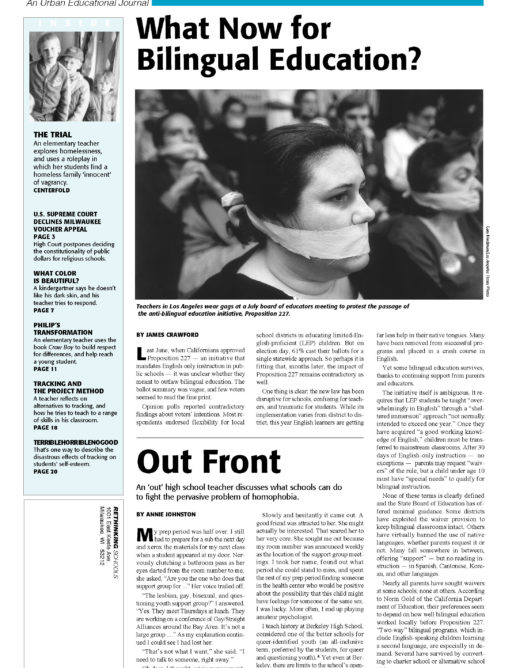Preview of Article:
What Now for Bilingual Education?
California public schools enrolled more than 1.4 million English learners last fall – six times the number in 1978 – representing one-quarter of all students, K-12, and one-third of those entering the first grade. With 42% of the LEP students nationwide, California is inevitably a trend-setter in bilingual education, both pedagogically and politically. Proposition 227 has shut down not only some excellent programs but also a source of continuing innovations. In addition, it has encouraged anti-bilingual movements across the country.
Hoping to build on his victory in California, Ron Unz has already launched a campaign for English-only schooling in Arizona. Similar efforts are possible in other states that make laws by ballot initiative, such as Colorado, Washington, and Massachusetts.
In Congress, House Republicans have taken up the cause. Last summer they passed a bill to end federal grants for bilingual education, turn funding decisions over to the states, limit civil rights enforcement, and require schools to mainstream English learners within two years. Without opposition from the Clinton Administration, which kept these provisions out of the 1999 budget agreement, the 30-year-old program could have been destroyed. This year it will face further challenges, as the Bilingual Education Act comes up for reauthorization.
Yet many Republicans are having second thoughts about spearheading this “wedge issue.” In the November elections, they lost major offices in California, as Latinos voted in record numbers and three out of four backed Democratic candidates. By contrast, in Texas and Florida, the sons of former President Bush garnered substantial Hispanic support in winning their gubernatorial races. These Republicans campaigned extensively in Spanish and Governor George W. Bush made a special point of supporting bilingual education in Texas.
Still, as the California initiative demonstrates, the appeal of anti-bilingual measures can cross party lines.

